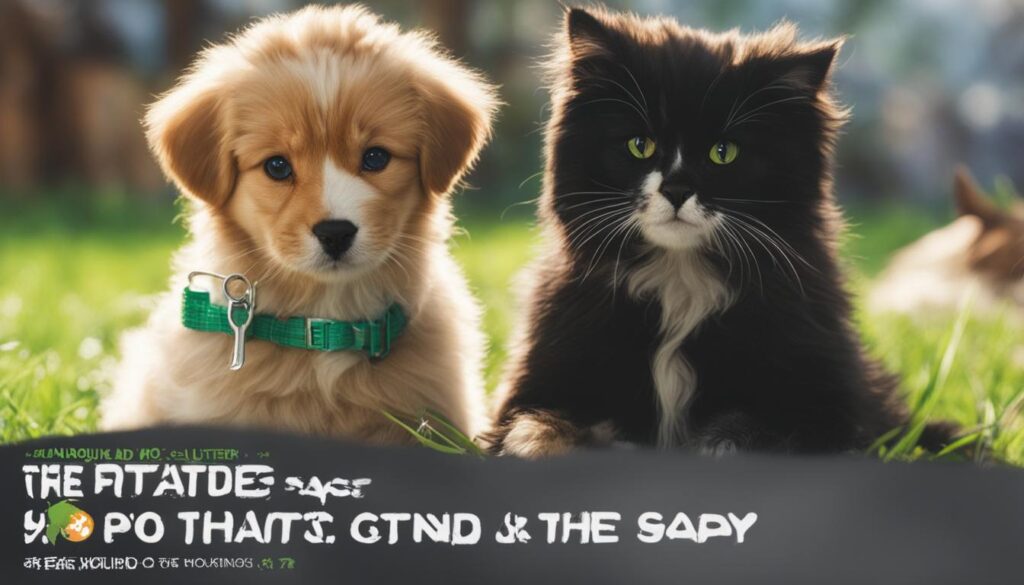The question of whether cats and dogs can mate is a common one. People are curious about the possibility of crossbreeding between these two species. In order to understand the truth behind this myth, we need to delve into the facts of feline and canine reproductive compatibility. Let’s explore the scientific evidence and data surrounding this topic.
Key Takeaways
- Cats and dogs have different reproductive systems, which affects their ability to mate
- Genetic compatibility plays a crucial role in successful breeding between species
- Despite common misconceptions, crossbreeding between cats and dogs is highly unlikely
- Ethical considerations and responsible pet ownership discourage cat and dog crossbreeding
- Spaying and neutering are effective ways to prevent accidental crossbreeding
The Reproductive Biology of Cats and Dogs
Cats and dogs have distinct reproductive systems that affect their ability to mate successfully. Understanding these differences is crucial to comprehending why crossbreeding between these species is highly unlikely.
Female cats have a reproductive cycle called estrus, during which they experience a period of receptivity to mating. This cycle is characterized by changes in behavior and physical signs, such as vocalization, rubbing against objects, and presenting the hindquarters. Male cats have barbed penises, which facilitate successful mating by inducing ovulation in the female.
In contrast, female dogs have a regular estrous cycle, which consists of several stages, including proestrus, estrus, and anestrus. Female dogs typically mate during the estrus phase, when they are sexually receptive. Male dogs, however, do not possess any specific physical adaptations for mating with cats.
Female cats have a reproductive cycle known as estrus, where they experience a period of receptivity to mating. Male cats have barbed penises, which facilitates successful mating by inducing ovulation in the female.
These reproductive differences between cats and dogs, including the hormonal changes, mating behaviors, and physical attributes, make it highly improbable for them to produce offspring together. The unique reproductive biology of each species ensures that they remain separate and distinct.
Genetic Compatibility of Cats and Dogs

Genetic compatibility is a key factor in determining the potential for breeding between different species. When it comes to cats and dogs, their genetic differences pose significant barriers to interbreeding. These differences include variations in the number of chromosomes and the overall genetic makeup.
One of the primary challenges for crossbreeding cats and dogs is the difference in their chromosome numbers. Cats typically have 19 pairs of chromosomes, while dogs have 39 pairs. This discrepancy in chromosome count creates a fundamental genetic barrier that makes it exceedingly difficult for the genetic material of cats and dogs to merge successfully.
Furthermore, cats and dogs have evolved separately over millions of years, resulting in considerable genetic divergence. Their distinct evolutionary paths have led to specialized traits and adaptations that are specific to each species. These genetic differences further impede the compatibility between cats and dogs, making successful crossbreeding unlikely.
While there have been rare cases of hybridization between closely related species, such as wolves and dogs, the genetic distance between cats and dogs is too vast to overcome. The unique genetic makeup and reproductive biology of both species form formidable barriers that prevent the production of viable offspring.
Ultimately, the genetic compatibility between cats and dogs presents significant challenges for crossbreeding. The distinct chromosome numbers and genetic divergence between these two species create insurmountable barriers that hinder successful interbreeding.
Common Misconceptions about Cat-Dog Hybrids

Despite the scientific evidence against cat-dog hybrids, there are still common misconceptions and myths surrounding this topic. Some people believe that crossbreeding cats and dogs can lead to unique and desirable traits in the offspring. However, these claims are not supported by scientific evidence. It is essential to dispel these misconceptions and promote accurate information about feline and canine reproduction.
“Crossbreeding cats and dogs can create a hybrid with the best traits of both species.”
One of the most prevalent misconceptions about cat-dog hybrids is the belief that crossbreeding can result in offspring with the best traits of both species. However, this is simply not the case. Cats and dogs have evolved separately for thousands of years, developing distinct genetic characteristics specific to their species. Attempting to combine these genetic traits through crossbreeding would not result in a harmonious blend of the best traits, but rather a mixture that may be genetically unstable and potentially detrimental to the health and well-being of the offspring.
“Cat-dog hybrids are hypoallergenic and do not trigger allergies like purebred cats or dogs.”
Another common misconception is that cat-dog hybrids would be hypoallergenic and not trigger allergies like purebred cats or dogs. However, allergies are primarily caused by proteins found in an animal’s fur, skin, and saliva, which are produced regardless of breed or hybrid status. While individual animals may produce fewer allergens compared to others, it is impossible to guarantee that cat-dog hybrids would be hypoallergenic. Therefore, for individuals with allergies, it is recommended to consider hypoallergenic breeds or alternative pets rather than expecting a cat-dog hybrid to be a suitable option.
“Crossbreeding cats and dogs can create a new species with extraordinary traits.”
Some people believe that crossbreeding cats and dogs could lead to the creation of an entirely new species with extraordinary traits. However, the process of speciation takes millions of years and requires a significant genetic divergence between populations. Cats and dogs, despite their superficial similarities as household pets, belong to different biological families: Felidae and Canidae, respectively. The genetic differences between these families are substantial, making it unlikely for viable crossbreeding to occur and produce a new species.
“Hybrids of cats and dogs would be low-maintenance and easy to care for.”
One misconception is that hybrids of cats and dogs would be low-maintenance and easy to care for, combining the independence of cats with the loyalty of dogs. However, the characteristics of hybrids, if any, would be unpredictable due to the complex interaction of genes from different species. Hybrids may exhibit traits from either parent or a combination of both, resulting in unique care requirements that may differ from both cats and dogs. Furthermore, proper care and responsible ownership remain fundamental regardless of the pet’s genetic makeup.
It is important to address these misconceptions and educate pet owners about the limitations and risks associated with crossbreeding cats and dogs. By promoting accurate information about feline and canine reproduction, we can ensure the well-being of both species and encourage responsible pet ownership.
Ethical Considerations of Crossbreeding Cats and Dogs

Apart from the scientific limitations, it is essential to consider the ethical implications of cat-dog crossbreeding. Responsible pet ownership practices prioritize the welfare and well-being of animals, including feline and canine companions.
When contemplating crossbreeding cats and dogs, it is crucial to acknowledge the potential animal welfare concerns that may arise. The process of mating between different species can pose significant health risks to both the parents and the offspring.
While there may be curiosity about creating unique and desirable traits in the offspring, it is important to recognize that these claims are not supported by scientific evidence. Breeding cats and dogs without a valid purpose can contribute to overpopulation and the abandonment of unwanted mixed-breed animals.
Responsible pet ownership involves making informed decisions that prioritize the health and well-being of our beloved companions. Instead of focusing on crossbreeding, it is advisable to celebrate the unique qualities of cats and dogs as individual species.
“The welfare of animals should always be our highest priority. Breeding cats and dogs without considering the ethical implications can have detrimental effects on the health and happiness of these animals.”
By promoting responsible pet ownership and discouraging cat-dog crossbreeding, we can protect the welfare of our furry friends and ensure a harmonious coexistence between different species.
Table: Ethical Implications of Crossbreeding Cats and Dogs
| Ethical Considerations | Impact |
|---|---|
| Animal Welfare | Potential health risks to parents and offspring |
| Overpopulation | Contributes to the abandonment of mixed-breed animals |
| Responsible Pet Ownership | Prioritizes the well-being and health of companion animals |
As responsible pet owners, it is our duty to make informed decisions that prioritize the welfare of our pets. Instead of pursuing cat-dog crossbreeding, let us focus on responsible care, spaying and neutering, and providing a loving and nurturing environment for our feline and canine companions.
The Importance of Spaying and Neutering

Spaying and neutering cats and dogs is vital for both their well-being and the prevention of accidental crossbreeding. These procedures not only help control the population of unwanted animals but also offer numerous health benefits for pets.
Spaying, the surgical removal of the ovaries and uterus in female pets, prevents them from going into heat and eliminates the risk of pregnancy. Neutering, the removal of the testicles in male pets, reduces aggressive behavior and the urge to roam in search of mates.
By spaying and neutering our pets, we contribute to the solution of pet overpopulation and reduce the number of stray animals in our communities. Every year, countless cats and dogs are euthanized or left homeless because there simply aren’t enough homes to accommodate them all.
The Benefits of Spaying and Neutering
- Prevents Unwanted Litters: Spaying and neutering eliminate the risk of unplanned pregnancies, reducing the number of homeless animals and the strain on animal shelters.
- Health Benefits: Spayed females have a lower risk of mammary gland tumors, uterine infections, and certain types of cancers. Neutering males can prevent testicular cancer and reduce the risk of prostate problems.
- Improved Behavior: Spaying and neutering can help reduce aggressive behavior, excessive marking, and the urge to roam in search of mates.
- Longer Lifespan: By eliminating the risk of certain diseases and reducing the likelihood of injuries caused by wandering, spayed and neutered pets generally live longer, healthier lives.
“Spaying and neutering our pets not only helps control the pet population, but it also promotes better health and improved behavior.”
It’s essential to spay and neuter our pets at the appropriate age, which is typically around six months for both cats and dogs. It’s a simple and routine procedure performed by veterinarians, and the benefits far outweigh any potential risks. By responsibly spaying and neutering our pets, we not only enhance their quality of life but also contribute to the overall welfare of animals in our communities.
| Benefits of Spaying and Neutering | Cats | Dogs |
|---|---|---|
| Prevents Unwanted Litters | ✔️ | ✔️ |
| Reduces Risk of Certain Cancers | ✔️ | ✔️ |
| Improved Behavior | ✔️ | ✔️ |
| Longer Lifespan | ✔️ | ✔️ |
The Uniqueness of Cats and Dogs as Separate Species

Cats and dogs are fascinating creatures, each with their own distinct characteristics that make them truly unique. It is important to appreciate and understand the individuality of these species, rather than attempting to crossbreed them. Both cats and dogs have evolved separately over thousands of years, adapting to different environments and lifestyles. Let’s explore the distinguishing characteristics of cats and dogs that contribute to their uniqueness.
Distinguishing Characteristics of Cats
Cats are known for their grace, agility, and independent nature. They have excellent night vision and are skilled hunters. Their retractable claws and flexible bodies allow them to climb trees, pounce on prey, and land safely on their feet. Cats are also highly territorial and mark their territory using scent glands. Their purring is a unique trait that signifies contentment and relaxation. Furthermore, cats are obligate carnivores, requiring a diet rich in animal proteins for optimal health.
Distinguishing Characteristics of Dogs
Dogs are known for their loyalty, sociability, and strong sense of smell. They have been selectively bred for various tasks and exhibit a wide variety of physical traits and temperaments. Dogs are pack animals and thrive in social groups, forming strong bonds with their human companions. They have a keen sense of smell, which enables them to detect scents and track trails. Dogs also exhibit a wide range of specialized behaviors, from herding to guarding and search and rescue.
| Cats | Dogs | |
|---|---|---|
| Genus | Felis | Canis |
| Families | Felidae | Canidae |
| Number of Chromosomes | 38 | 78 |
| Reproduction | Females go into heat (estrus) | Females have a regular estrous cycle |
| Mating Behavior | Males have barbed penises | Males do not have specialized mating adaptations |
| Diet | Obligate carnivores | Opportunistic omnivores |
The Joy of Pet Companionship

While cats and dogs may not be able to mate and produce offspring together, they both offer unique companionship and joy as individual species. Owning a cat or a dog can provide numerous benefits, such as emotional support, stress relief, and increased social interaction. The bond between humans and their pets is a special one that should be cherished, regardless of the possibility of crossbreeding.
Pets, whether cats or dogs, bring immense happiness and fulfillment to our lives. The benefits of owning a cat go beyond their adorable purrs and graceful agility. Cats have a calming presence and can reduce stress levels. Petting a cat has been shown to lower blood pressure and release endorphins, helping to create a sense of peace and relaxation. Additionally, cats are known for their independent nature, which can be a source of inspiration and encourage a sense of freedom in their owners.
Owning a dog, on the other hand, provides an entirely different experience of pet companionship. Dogs are known for their loyalty and unwavering devotion to their owners. The presence of a dog can increase social interactions and encourage a more active lifestyle. Taking a dog for a walk or playing fetch in the park not only benefits the physical health of the dog but also promotes exercise and social connections for the owner. Dogs have also been shown to provide emotional support and improve mental health, particularly in individuals dealing with anxiety or depression.
Pets, whether cats or dogs, can also serve as powerful allies in pet therapy. The presence of an animal can provide comfort and emotional support to individuals suffering from various physical and mental health conditions. Pet therapy has been shown to reduce anxiety, improve mood, and even lower heart rate and blood pressure. The unconditional love and acceptance of a pet can have a profound impact on the emotional well-being of individuals, particularly those dealing with trauma or chronic illness.
In conclusion, the joy of pet companionship goes beyond the possibility of crossbreeding between cats and dogs. Both cats and dogs offer unique benefits, from stress relief and emotional support to increased social interaction and physical activity. Whether you choose to own a cat or a dog, the bond between humans and their pets is a precious and meaningful connection that brings immense joy and fulfillment.
Wrapping Up
In conclusion, the notion of cats and dogs mating and producing offspring together is nothing more than a myth. The differences in their reproductive biology and genetic makeup create significant barriers to successful crossbreeding. Female cats have a unique estrus cycle and barbed penises, while female dogs have a regular estrous cycle without any physical adaptations for mating with cats. These distinct differences make it highly unlikely for cats and dogs to mate and produce viable offspring.
Furthermore, ethical considerations and responsible pet ownership practices discourage the intentional crossbreeding of cats and dogs. Responsible breeding prioritizes the welfare and health of the animals involved, and attempting to mate cats and dogs can pose significant risks to both the parents and the offspring. It is crucial to respect and appreciate the individuality and unique characteristics of each species, rather than trying to force them to mate.
Instead of focusing on the potential for crossbreeding, pet owners should celebrate the distinctive traits and qualities that cats and dogs bring to our lives. Both species offer unconditional love, companionship, and emotional support. By providing responsible care and nurturing a strong bond, we can ensure the well-being of our beloved pets and experience the joy of their companionship without perpetuating the misconception of cats and dogs mating.
FAQ
Can cats and dogs mate and produce offspring together?
No, cats and dogs cannot mate and produce viable offspring. They have different reproductive systems and genetic makeup, which make crossbreeding unlikely.
What are the reproductive differences between cats and dogs?
Female cats have a reproductive cycle known as estrus, while female dogs have a regular estrous cycle. Male cats have barbed penises, which facilitate successful mating, while male dogs do not have any physical adaptations for mating with cats.
Is there genetic compatibility between cats and dogs?
Cats and dogs have different numbers of chromosomes and significant genetic divergence, making it challenging for their genetic material to combine and produce viable offspring.
What are some common misconceptions about cat-dog hybrids?
Some people believe that crossbreeding cats and dogs can lead to desirable traits in the offspring, but there is no scientific evidence to support these claims.
What are the ethical considerations of crossbreeding cats and dogs?
Crossbreeding cats and dogs can pose health risks to both the parents and offspring and contribute to overpopulation and the abandonment of mixed-breed animals.
Why is spaying and neutering important in preventing accidental crossbreeding?
Spaying and neutering not only prevent unwanted litters but also offer health benefits for the animals, reducing the risk of certain cancers and behavioral issues.
How are cats and dogs unique as separate species?
Cats and dogs have evolved separately, adapted to different environments, and have their own set of characteristics and behaviors.
What are the benefits of pet companionship?
Owning cats or dogs can provide emotional support, stress relief, and increased social interaction for humans.
Is it possible for cats and dogs to mate?
No, scientific evidence does not support the possibility of successful mating between cats and dogs.






